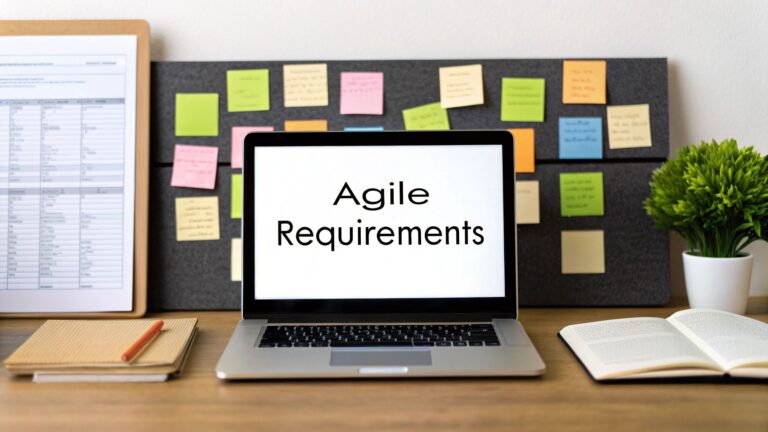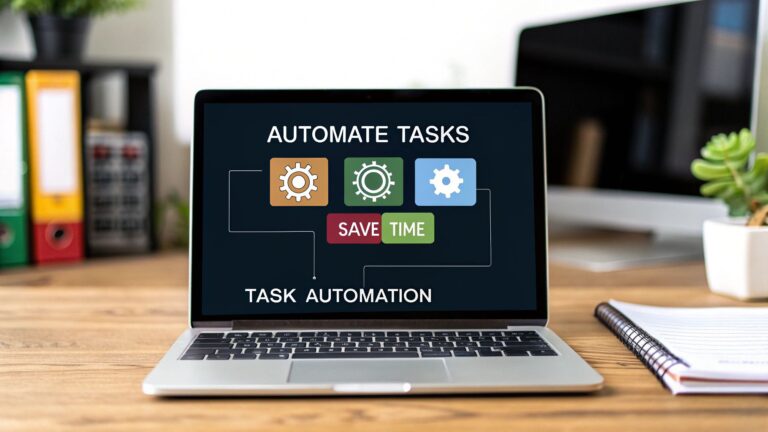Project Management Waterfall vs Agile A Guide
The real heart of the Waterfall vs. Agile debate comes down to a simple choice: Do you need a predictable, step-by-step plan, or do you need the flexibility to adapt on the fly? Waterfall is a linear, sequential approach—each phase of the project must be fully completed before you can even think about starting the next one. Agile, on the other hand, is an iterative, flexible method that delivers work in small, digestible chunks.
Which one you choose ultimately depends on whether your project demands absolute predictability or the freedom to embrace change.
Choosing Your Project Management Methodology
Picking between Waterfall and Agile isn't about which one is "better." It's about finding the right tool for the specific job you're doing.
Think of it this way: if you're building a bridge, you need a highly detailed blueprint and a fixed sequence of steps. You can't start pouring concrete for the road deck before the support pillars are finished. That rigid, predictable process is exactly what the Waterfall model provides. Everything is planned upfront, and each phase locks into place before the next one begins.
Now, imagine you're creating a new mobile app. The market is constantly changing, and user feedback is gold. You need a process that lets you test ideas, get the app into users' hands quickly, and pivot based on what you learn. That’s where Agile excels. It breaks the project down into small cycles, often called sprints, allowing for continuous improvement and making it easy to adapt as you go.
The right choice always comes down to your project's specific context, your team's working style, and what you’re ultimately trying to achieve.
Waterfall vs Agile At a Glance
To really see how different these two approaches are, it helps to put them side-by-side. The table below gives you a quick snapshot of their core philosophies and how they operate in the real world.
| Characteristic | Waterfall | Agile |
|---|---|---|
| Structure | Linear and sequential phases | Iterative and incremental sprints |
| Planning | All planning is done upfront | Planning is continuous and adaptive |
| Requirements | Fixed and defined at the start | Evolving and can change |
| Client Feedback | Limited to specific milestones | Continuous throughout the project |
| Delivery Model | One final product delivery | Frequent, small deliveries |
| Change Management | Changes are difficult and costly | Changes are welcomed and expected |
This comparison makes it clear: Waterfall is built for stability, while Agile is built for change. Neither is inherently superior, but one will almost certainly be a better fit for your project's needs.
Success Rates and Adoption Trends
The data tells a compelling story about how teams are working today. A recent study shows that pure Agile adoption has climbed to 61%, far surpassing Waterfall's 32%. This isn't just a trend; it's reflected in the results. A full 64% of Agile projects are considered successful, which is nearly 1.5 times higher than Waterfall's 49% success rate.
The contrast is even sharper when you look at project failures. The failure rate for Waterfall projects is almost three times higher at 21%, compared to just 8% for Agile projects.
These numbers suggest that in today's fast-moving world, Agile's focus on iteration and continuous feedback gives projects a much better chance of hitting the mark. You can dive deeper into these project management findings and their implications. It’s a clear signal that understanding the nuances of the Waterfall vs. Agile comparison is crucial for any team aiming for consistent success.
The Foundational Waterfall Methodology Explained
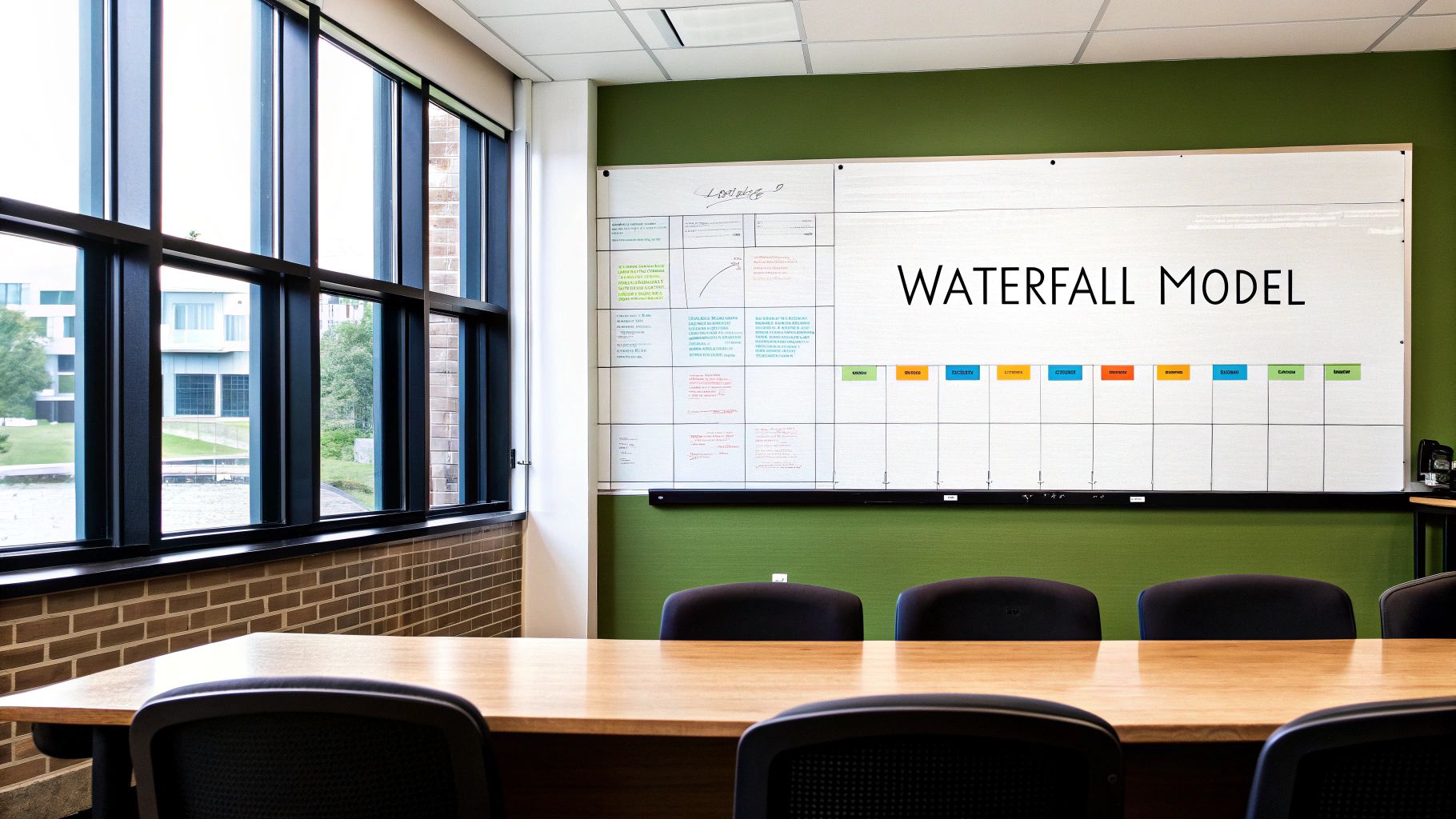
Before we can really dig into a Waterfall vs. Agile comparison, we need to get a solid handle on the Waterfall model itself—where it came from and how it’s built. Its DNA comes from old-school manufacturing and construction, fields where you absolutely have to do things in a specific order. You can’t put the roof on a house before the walls are up, right? That’s the core logic of Waterfall.
The name says it all. Each stage flows down into the next, just like a waterfall. Progress moves in one direction only, and one phase must be 100% complete and formally signed off before the next one can even start. This creates a project lifecycle that's incredibly structured, predictable, and documented down to the last detail.
This strict, linear path makes Waterfall a go-to for projects where the requirements are crystal clear from day one and aren't expected to change. Think about building a data center or engineering a new medical device—you need absolute precision and no surprises from the initial blueprint.
The Distinct Phases of a Waterfall Project
What truly defines a Waterfall project is its series of distinct, non-overlapping phases. The names might change a bit from company to company, but this rigid progression is the bedrock of the entire approach.
-
Requirements Gathering: This is the first—and most important—step. Every single project requirement is gathered, picked apart, and documented in exhaustive detail. There's no wiggle room here; this document is the project's bible.
-
System Design: With the requirements set in stone, the team gets to work designing the system's architecture. This covers everything from the logical design (what it does) to the physical design (the hardware and software needed to do it).
-
Implementation: Here’s where the actual building happens. Developers take the design documents and start coding, assembling the product piece by piece, sticking to the plan without deviation.
-
Testing and Verification: Once the build is finished, the QA team takes over. They put the entire system through its paces, testing it against the original requirements to hunt down and squash any bugs.
-
Deployment and Maintenance: After the product passes all tests, it’s released to the end-users. From there, the project moves into its final phase: ongoing support and maintenance to handle any issues that pop up after launch.
Each of these steps acts as a gate. You simply can't move on to the next phase until the current one is completely finished and approved. This meticulous structure is both Waterfall's biggest advantage and its most glaring flaw.
Strengths and Critical Weaknesses
The main draw of the Waterfall methodology is its simplicity. It’s predictable. With all requirements defined upfront, managers can map out detailed timelines, budgets, and resource plans with a high degree of confidence. The heavy focus on documentation also means knowledge is easy to pass along and progress is simple to measure against clear milestones.
But that same rigidity is what makes it a poor fit for many modern projects.
The core challenge with Waterfall is its inability to accommodate change. If a market shift or user feedback reveals a flaw in the initial requirements midway through the project, making a change is exceptionally difficult and expensive.
This inflexibility means big risks often don't surface until it's too late—sometimes not until the product is already in the testing phase. A simple misunderstanding during the requirements stage can lead to a product that works exactly as designed but completely misses the mark on what users actually need, triggering costly and time-consuming rework. This is a key reason why effective resource allocation and optimization must be a priority from the very start.
In the end, the Waterfall model shines in stable environments with a fixed scope. But for any project that needs to adapt to new information or faces even a hint of uncertainty, its rigid, one-way path is often too restrictive, which is why more flexible alternatives started to emerge.
A Deep Dive into the Agile Philosophy and its Frameworks
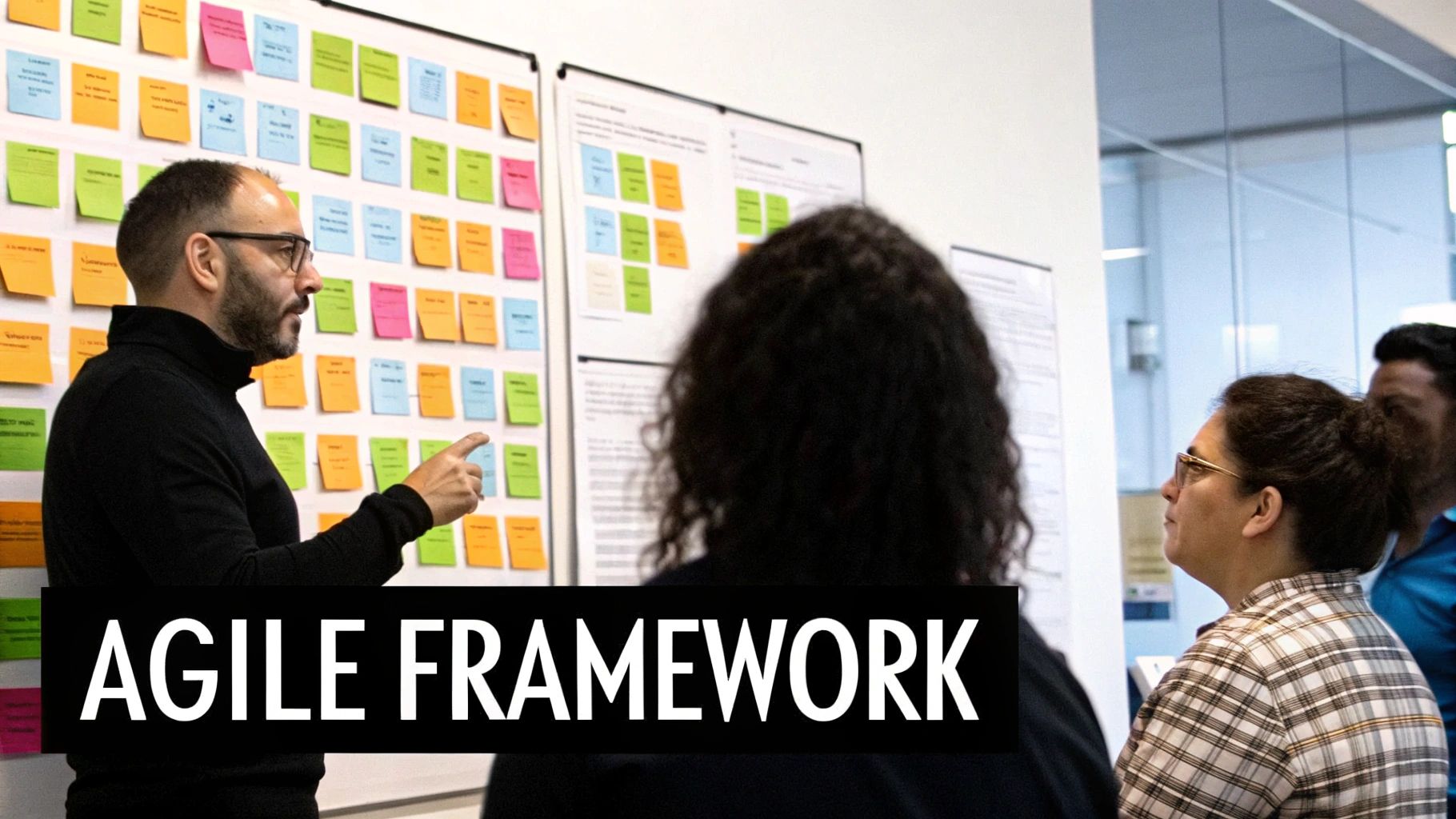
If Waterfall is a rigid, top-down instruction manual, then Agile is more of a guiding philosophy. It’s a complete mindset shift, grounded in the core values of the Agile Manifesto: putting individuals and interactions before processes, valuing working software over exhaustive documentation, collaborating with customers instead of just negotiating contracts, and being able to respond to change rather than blindly following a plan.
This philosophy changes the game. The goal isn't just to deliver a pre-defined product at the end of a long road; it's about delivering continuous, tangible value along the way. Agile not only accepts but embraces the fact that you can't possibly know everything at the start of a complex project. It turns that uncertainty into an advantage by creating a system designed to learn and adapt as it goes.
This adaptive nature is a massive differentiator in any discussion about project management. It's no surprise that Agile has become the go-to approach for so many, with around 73% of projects now using its practices. This adoption is largely powered by popular frameworks like Scrum and Kanban, which are used by 58% and 56% of Agile teams, respectively.
Understanding Scrum and Sprints
Scrum is easily the most popular framework for putting the Agile philosophy into practice. It offers a lightweight but structured way for teams to break down massive, complex problems into small, manageable pieces. The whole process revolves around sprints—short, time-boxed cycles, usually lasting between one and four weeks, where the team focuses on completing a specific set of work.
Each sprint kicks off with a planning meeting to decide what the team will build and wraps up with a review to show stakeholders what they’ve accomplished. This cyclical process creates a constant feedback loop, allowing the team to shift priorities based on what they're learning from real-world input.
At its heart, Scrum creates a rhythm of delivery. Instead of one big launch at the very end, the team produces a potentially shippable piece of the product after every single sprint. This ensures consistent progress and dramatically reduces project risk.
This iterative delivery model is a cornerstone for https://makeautomation.co/how-to-increase-team-productivity/, as it keeps everyone locked in on delivering real value in short, focused bursts.
Visualizing Work with Kanban
While Scrum is all about the rhythm of sprints, Kanban takes a more fluid approach. Its main focus is on visualizing the entire workflow and limiting the amount of work in progress (WIP) at any given time. The key tool here is the Kanban board, a simple visual chart that shows tasks moving through different stages, like "To Do," "In Progress," and "Done."
The whole point of Kanban is to create a smooth, continuous flow of work. By setting limits on how many tasks can be in any one stage, teams can instantly spot bottlenecks where work is getting stuck. This visual clarity makes it easier to balance the team's workload and improve efficiency without the pressure of a sprint deadline.
Kanban's flexibility makes it a great fit for teams that handle a constant stream of incoming tasks rather than working on distinct project phases, like IT support or content marketing teams. To see how these ideas are applied in a specific field, this guide to Agile Mobile App Development offers some great insights. Ultimately, both Scrum and Kanban provide practical ways to turn the abstract Agile philosophy into real-world action, helping teams build better products, faster.
Comparing Critical Project Management Elements
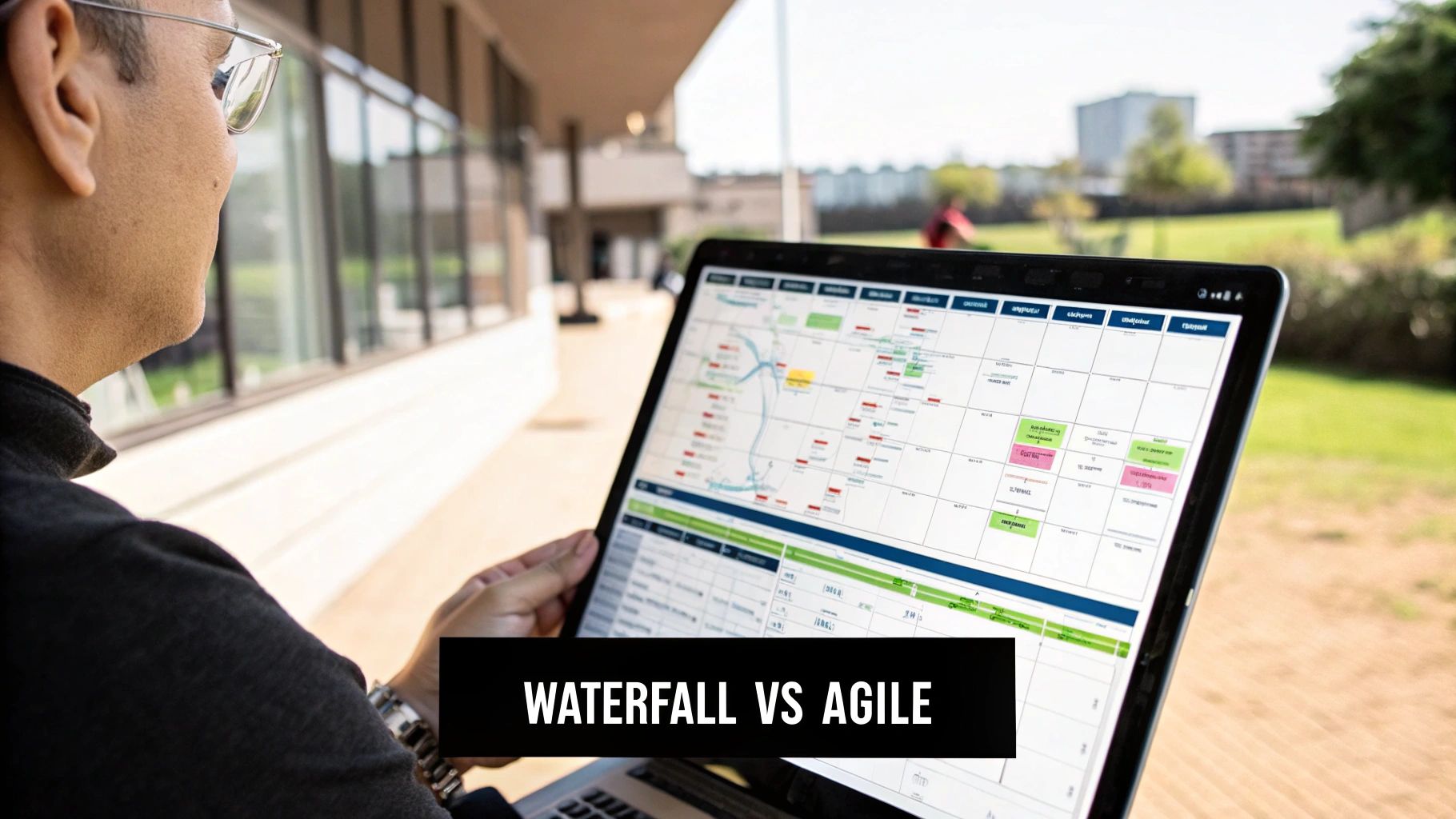
To really get to the heart of the Waterfall vs. Agile debate, you have to look past the surface-level definitions. The real difference lies in how each methodology handles the messy, real-world work of managing a project day-to-day. Their philosophies create two completely different worlds when it comes to planning, dealing with change, and handling risk.
This isn't just about process; it's a fundamental split in perspective. Waterfall operates as if a project is a predictable, linear equation to be solved perfectly. Agile, on the other hand, treats a project like an expedition into uncharted territory—one that requires constant course correction.
Planning and Requirements Definition
With a Waterfall project, planning is a massive, front-loaded effort. You define the entire scope, map out the full timeline, and lock down the budget before a single line of code is written or a single deliverable is built. This upfront planning creates a rigid, comprehensive blueprint that the team is expected to follow to the letter.
This method assumes that all project requirements can be fully understood and documented from day one. Once the stakeholders sign off on that document, it becomes the project's constitution—set in stone and guiding every single step that follows.
Agile couldn't be more different. It treats planning as a continuous, adaptive activity. You start with a high-level vision, but the nitty-gritty details are fleshed out in small batches at the beginning of each short cycle, or sprint. The core assumption is that requirements will change as the team learns and gets feedback.
Waterfall’s rigid structure assumes you can know everything upfront. Agile’s iterative nature assumes you can’t—and that learning as you go is a competitive advantage.
This is a critical distinction. Waterfall’s strength is its predictability when nothing changes. But if the market shifts or a better idea comes along mid-project, Agile’s inherent flexibility gives it a massive edge.
Client Involvement and Feedback Loops
Another huge point of contrast is the role of the client. In a classic Waterfall setup, client involvement is intense at the very beginning (for requirements gathering) and at the very end (for the final sign-off). What happens in between? Not much.
Communication during the long development phase is often formal and infrequent. The client has to trust that the initial plan was perfect and then wait—sometimes for months or even years—for the big reveal.
Agile completely inverts this model by demanding continuous client collaboration. Stakeholders aren't just outsiders; they are active, integral members of the project team. They might join daily meetings, participate in sprint reviews, and help prioritize work for the next cycle. This constant feedback loop is the best insurance you have that the final product will actually solve their problem.
Real-World Example
- Waterfall Scenario: A government agency needs a new public records portal. They spend six months meticulously defining every single requirement. The plan is signed off, and then they wait 18 months for the finished product. When it’s delivered, they realize a critical feature was based on a misunderstanding, but changing it now is prohibitively expensive.
- Agile Scenario: A startup is building a new e-commerce app. Every two weeks, they release a working slice of the app to a small group of beta users. The users' feedback immediately informs what the team builds next, ensuring the final product is something people genuinely want and will use.
Handling Change and Mitigating Risk
Perhaps the most telling difference between Waterfall and Agile is how they treat change. For Waterfall, change is the enemy. Because the entire project is built on a fixed set of initial requirements, any deviation triggers a formal—and often painful—change control process.
By its very design, the model resists change. This becomes a major liability because risks often don't surface until the very end, usually during the testing phase. By then, fixing the problem is at its most expensive and disruptive point.
Agile, by contrast, is built to embrace change. The short, iterative cycles are there for a reason: they create planned opportunities to adjust course based on new feedback or information. This structure naturally minimizes risk by forcing it into the open early and often.
Instead of crossing your fingers and hoping for the best until the final deadline, an Agile team gets a reality check every couple of weeks. This ongoing validation means big problems are spotted and squashed while they're still small, preventing the kind of last-minute disasters that can sink a project.
To see these differences side-by-side, let's break down how each methodology approaches key project management functions.
Functional Comparison of Waterfall vs Agile
| Function | Waterfall Approach | Agile Approach |
|---|---|---|
| Planning | Exhaustive, upfront planning for the entire project. The plan is the master blueprint. | Adaptive, continuous planning. High-level vision is set, but details emerge each cycle. |
| Requirements | Defined in full at the start and "frozen." Change is formally controlled and discouraged. | Evolve throughout the project. New requirements can be added in any sprint. |
| Delivery Cycle | One single delivery at the end of the project timeline. | Frequent, incremental deliveries of working software at the end of each sprint. |
| Feedback Loop | Feedback is gathered at the end of major phases, primarily during final testing. | Continuous feedback from stakeholders and users at the end of every short cycle. |
| Change Management | Views change as a disruption. Requires a formal, bureaucratic change request process. | Welcomes and expects change. It's incorporated into the backlog for future sprints. |
| Risk Mitigation | Risks are identified upfront, but major issues are often discovered late in the process. | Risk is mitigated iteratively. Issues are identified and addressed every few weeks. |
| Team Structure | Hierarchical and role-based. Work is handed off between specialized teams (e.g., analysts to developers to testers). | Cross-functional, self-organizing teams that own features from concept to completion. |
This table highlights the fundamental operational divide. Waterfall is about control and predictability, while Agile is about adaptation and value delivery. Neither is universally "better," but they are built to solve very different kinds of problems.
Choosing the Right Model for Your Project
Picking between Waterfall and Agile isn't just about personal preference—it's a critical strategic decision that hinges on the very DNA of your project. To make the right call, you have to be brutally honest about your goals, your constraints, and the environment you’re working in. There's no single "best" option, only the one that’s best suited for the job.
I like to think of it like picking a vehicle for a trip. If you're heading down a straight, perfectly paved highway with a known destination, a freight train is a fantastic choice. It's powerful, predictable, and stays on its track. That’s Waterfall. But if you're navigating a dense, unmapped jungle, you need something else entirely—an all-terrain vehicle that can turn on a dime and adapt to whatever the trail throws at it. That’s Agile.
This fundamental difference between a fixed path and an adaptive one is at the heart of the debate. The trick is to really understand your project's nature before you commit to a methodology.
When to Select the Waterfall Model
Waterfall’s rigid, top-to-bottom structure makes it the go-to for projects where the requirements are set in stone and the scope is locked down from day one. In highly regulated industries or when you're working with fixed-price contracts, that kind of predictability is your greatest asset.
Think about these kinds of situations where Waterfall really shines:
- Aerospace and Defense: When you're building a new aircraft component, safety and engineering specs are non-negotiable. There is absolutely no room to iterate on core requirements once you've started.
- Medical Device Manufacturing: Developing a new MRI machine means following strict regulatory standards to the letter. The entire process needs meticulous documentation and must stick to a pre-approved plan.
- Large-Scale Construction: You can't build a skyscraper or a bridge without a detailed blueprint. The phases—foundation, framing, electrical—have to be done in a precise, linear sequence.
In these cases, success is all about stability, thorough documentation, and predictable execution. The cost of making a change mid-stream is so high that Waterfall’s intense upfront planning isn't just a nice-to-have; it's a necessity.
A core strength of Waterfall is its ability to provide clear, long-term visibility into timelines and budgets. When the finish line is fixed and the path is clear, its structured approach ensures everyone stays on track.
That kind of clarity is priceless when stakeholders demand a high degree of certainty from the get-go.
When to Embrace the Agile Approach
Agile comes alive in environments defined by uncertainty and the need for speed. It’s built for projects where you don't know exactly what the final product will look like and where learning by doing gives you a serious competitive edge.
Agile is the clear winner for projects like these:
- Software and App Development: Building a new mobile app is all about getting constant user feedback to refine features and keep up with market trends. Agile's short sprints let teams test, learn, and pivot fast.
- Marketing Campaigns: Launching a digital marketing campaign means trying out different messages, channels, and creative concepts to see what clicks. An Agile approach lets marketers optimize their strategy based on real-time data.
- Research and Development (R&D): When you're exploring a new technology or product idea, the path is inherently unpredictable. Agile gives you a framework to experiment, test your assumptions, and change direction based on what you discover.
For these projects, being able to respond to change is far more valuable than blindly sticking to the original plan. This shift in mindset is becoming more common; for instance, a staggering 80% of U.S. federal IT projects now use Agile or iterative methods, a huge leap from just 10% back in 2011. It shows that even traditionally rigid sectors see the value in adaptation.
Ultimately, the right decision comes down to your project's specific context. For a closer look at modern tools that can support either methodology, check out our guide on the 12 best AI tools for project management. It can help you put your chosen framework into action more effectively.
A Practical Framework for Making Your Decision
Choosing between Waterfall and Agile is more than just a theoretical debate; it’s a critical decision that directly impacts your budget, timeline, and the final product. To cut through the noise, you need a straightforward way to decide. It really comes down to asking a few honest questions about your project, your team, and your stakeholders.
The goal isn't to find a "perfect" system but the one that’s the best fit for your reality. Your project's specific goals and limitations should be the final word in the Waterfall vs. Agile conversation.
Key Diagnostic Questions to Ask
Before you commit, take a step back and think through these core questions. The answers will almost always point you in the right direction.
-
How Stable Are My Project Requirements?
If you can confidently lock down 100% of the project requirements from day one with little chance of them changing, Waterfall is a solid choice. But if you anticipate that user feedback or market shifts will force you to adapt, Agile’s flexible approach is a much safer bet. -
How Involved Will the Client or Stakeholder Be?
Agile is built for projects where clients want to be in the loop, providing regular feedback along the way. If your stakeholders prefer to hand off the requirements and see the finished product at the end with minimal check-ins, Waterfall's structured, sequential process will better meet their expectations. -
How Does My Team Handle Change and Uncertainty?
Agile works best with self-starting teams that can pivot quickly without needing strict, top-down direction. If your team is comfortable making decisions on the fly, they’ll thrive in an Agile setup. On the other hand, if your team performs best with a clear, step-by-step plan and well-defined roles, Waterfall provides the structure they need.
The right methodology aligns with your project's reality, not an idealized version of it. A mismatch between your project’s needs and your chosen framework is a direct path to frustration and failure.
Of course, the best methodology is only as good as the tools you use to manage it. To get more out of your planning process, it's worth exploring resources on digital planning for peak productivity.
This decision tree gives you a great visual for how factors like project complexity, flexibility, and team size can steer you toward either Waterfall or Agile.
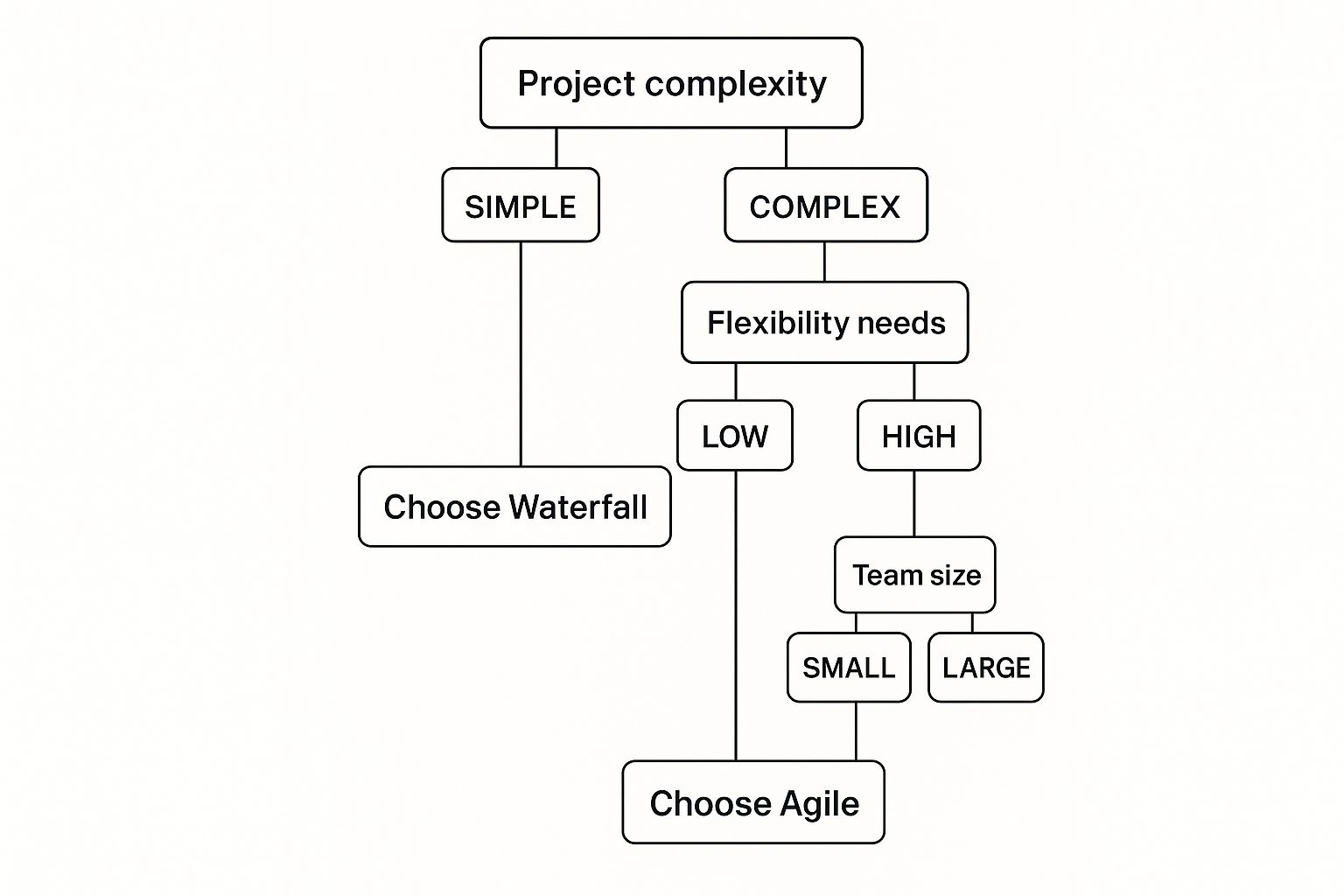
As you can see, Waterfall is tailor-made for simpler projects where flexibility isn't a priority. In contrast, Agile shines when you're tackling complex challenges that demand constant adaptation.
Frequently Asked Questions
https://www.youtube.com/embed/8HCKHZINNCQ
Can You Combine Waterfall And Agile?
Absolutely. In fact, many successful teams do just that. This blended approach is often called a hybrid model, and it's all about cherry-picking the best elements from each methodology to fit the project's unique needs.
For instance, you might use Waterfall's rigorous, upfront planning for the initial discovery and requirements-gathering phase. This is perfect for locking down the high-level scope and budget. Once that solid foundation is in place, the team can shift to Agile sprints for the hands-on development work, giving them the flexibility to adapt and iterate as they go. This strategy gives you the best of both worlds: predictability at the start and adaptability during execution.
Is Agile Always Better For Software Development?
It’s tempting to think so, especially with how popular Agile has become. But no, it's not a silver bullet. There are specific situations where the traditional Waterfall method is not just an option, but the better choice. This is especially true when project requirements are rock-solid and not expected to change.
Think about these kinds of projects:
- Embedded Systems: When you're building software for a medical device or an airplane's flight controls, there's no room for error. The requirements are fixed, heavily regulated, and must be followed to the letter.
- Mission-Critical Software: Imagine developing a core banking system or a power grid controller. Failure is simply not an option. Waterfall's phase-by-phase, highly documented process ensures every single detail is checked, double-checked, and signed off on before moving forward.
In these high-stakes scenarios, the control and predictability of Waterfall are far more valuable than the flexibility of Agile.
What Is The Biggest Challenge In Moving From Waterfall To Agile?
It’s not about the tools or the new terminology. The single biggest hurdle in switching from Waterfall to Agile is cultural change. It’s a complete mindset overhaul, moving from a top-down, command-and-control way of working to one built on trust, collaboration, and team autonomy.
The transition demands moving away from a culture of rigid plans and hand-offs to one that embraces uncertainty, values continuous feedback, and trusts self-organizing teams to make decisions.
This is a massive shift. People who are used to having a complete, detailed plan handed to them can find the idea of an evolving backlog unsettling. Managers have to learn to step back and become facilitators rather than directors. It takes real leadership, a ton of communication about why the change is happening, and a healthy dose of patience. You're not just implementing a new process; you're changing deeply ingrained habits.
At MakeAutomation, we specialize in designing and implementing the precise project management frameworks that fit your business needs. Whether you require a structured Waterfall approach, a flexible Agile system, or a custom hybrid model, we provide the expertise to optimize your workflows and accelerate your growth. Find out how we can help at https://makeautomation.co.





